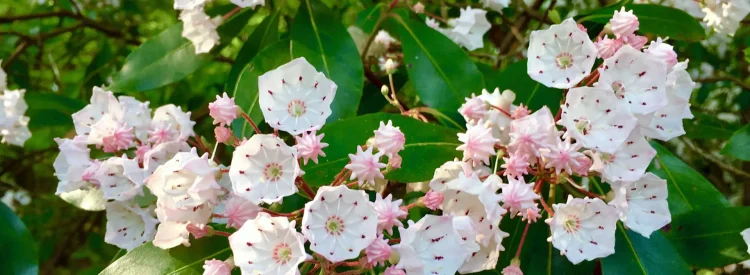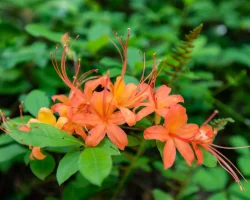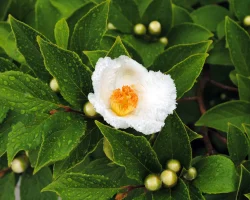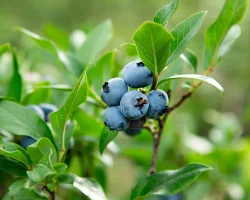Mountain laurel shrubs are stunning year-round, with glossy evergreen leaves and tiny, geometric flower clusters in the spring. Their branches twist to form sculptural arrangements. Growing mountain laurels is exceptionally easy: they require no fertilizer and are happy with rain after the first year. Spend a day planting a few and watch them return decades of fuss-free beauty.

Is mountain laurel a good choice for my yard?
Yes, if…
- You want a show-stopping shrub with year-round beauty.
- You’re looking for an evergreen that isn’t boring (looking at you, yews and boxwoods).
- You have a shady or part-shade spot—they’re understory shrubs by nature.
- You want a long-lived native that supports pollinators and requires minimal care.
- You’d like to replace non-native foundation shrubs with something far more interesting.
What are the benefits of planting native mountain laurel?
Mountain laurels are gorgeous native shrubs that are easy to grow and return decades of beauty. A native plant is a plant that has grown in an area for thousands of years. They have lived through every drought, storm, and crazy weather event and thrive on rain alone.
Planting native plants like mountain laurel helps your yard (and wildlife!) thrive:
- Attract wildlife: Native plants provide the best food and habitat for local butterflies and birds.
- Adapted to local conditions: Natives have evolved here for thousands of years; they’re perfectly suited to our soil, weather, and seasons.
- Less work, more beauty: Once established, native plants thrive on rainfall alone—perfect for laid-back gardening.
New to native?
Before lawns and landscaping, native plants were here. They’ve fed birds, bees, and butterflies for thousands of years—and they’ll do the same in your yard. The best part? They’re easier to grow than you think.

These are just a few reasons why planting native plants keeps our yards and landscaping gorgeous with less work. (Did you know lawns can take 2400% MORE TIME than native gardens?)
Now let’s meet some native mountain laurels that will look amazing in your yard. First, let’s get one similarly-named plant out of the way.
Mountain laurel vs. *Texas* mountain laurel
There are many species of mountain laurel native to America that fall into either the “mountain laurel” or “Texas mountain laurel” group.
Here is a quick overview:
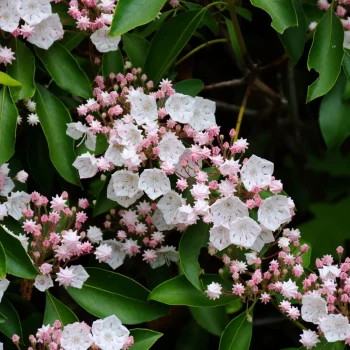
Mountain laurel
Kalmia genus
- Native to the Eastern U.S.
- Intricate, geometric-shaped flowers
- Latin names start with Kalmia
- Scroll on to learn about these plants!

Texas mountain laurel
Dermatophyllum secundiflorum
- Native to Texas through New Mexico
- Not related to Kalmia laurels, despite the name
- Fragrant purple flowers
- Read our plant profile for Texas mountain laurel
In this article, we’ll focus on the Kalmia genus
Within the Kalmia genus, there are many different native varieties and cultivars. These Kalmia mountain laurels are a perfect shrub to plant in highly visible areas—they always look great. If you live in the Northeast, Midwest, or Mid-Atlantic, plant a few mountain laurels when you can.
Meet the native mountain laurels
Here are mountain laurel species native to North America:
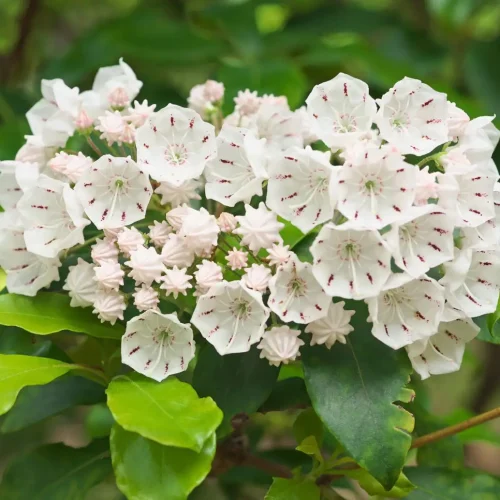
Mountain laurel
Kalmia latifolia
Native range: Found along the eastern United States, from Maine to Florida and west to Louisiana.
Description: This slow-growing evergreen shrub is loved for its clusters of delicate, geometric white or pale pink flowers in spring. Sometimes called “Spoonwood,” it can grow up to 8 feet tall and wide.
Ideal conditions: Thrives in shade to part-shade and moist, acidic soil.

Swamp mountain laurel
Kalmia polifolia
Native range: Found in wet, boggy environments across North America, particularly in cooler regions from Nova Scotia west to Manitoba and south to northern parts of the United States, including Michigan and New York.
Description: This small shrub averages 2-3 feet tall and wide and thrives in wet areas.
Ideal conditions: Prefers wet, acidic soils in part shade to full shade areas.
There are a few rare mountain laurel species
There are also a few other native mountain laurel species that hang out in the Kalmia genus. These others can be found in the wild or at botanic gardens, but they are rarely seen in plant nurseries. These other species include:
- Sheep laurel, native to the Northeast (Kalmia angustifolia)
- Mountain myrtle, native to the Southeast (Kalmia buxifolia)
Seen other colors? Those are probably mountain laurel cultivars
While you may not find these species in plant nurseries, you will probably find some mountain laurel cultivars bred or selected from these original native species.
You’ll know it’s a mountain laurel cultivar when you see a cheeky, marketing-speak name in ‘single quotes,’ following its Latin name. Some popular mountain laurel cultivars include:

Mountain laurel ‘Minuet’
Kalmia latifolia ‘Minuet’
- Striped flowers
- Cultivated to be short (3′ tall and wide)

Mountain laurel ‘Tinkerbell’
Kalmia latifolia ‘Tinkerbell’
- Bright pink, Barbie-like flowers
- Cultivated to be short (3′ high and wide)

Mountain laurel ‘Olympic Fire’
Kalmia latifolia ‘Olympic Fire’
- Hot pink buds that open into a lighter pink bloom
- Larger shrub (5′ tall and wide)
If you’re wondering if you should plant a true native over a cultivar (which is also sometimes ‘nativar’), we have a recommendation:
What is a cultivar?
Cultivar is short for CULTIvated VARieties. Cultivars are plants selected for traits like color, size, or disease resistance. Useful and sometimes stunning...but some lose the scent, shape, or timing wildlife depends on. Plant straight species when possible.
That said—if you fall in love with a cultivar, plant away. Planting a native cultivar is always more beneficial to wildlife than planting a non-native plant.
Now that you’ve met some native mountain laurels—you’re ready to plant some. Here’s the where and how, alongside some plant pairing inspiration.
FAQs
When do mountain laurels bloom?
On the East Coast, mountain laurels bloom from the spring to late spring. When mountain laurels are in bloom, they are knockouts. The Brooklyn Botanic Garden says it beautifully:
“In addition to being tolerant of shade, Kalmia latifolia produces exquisite clusters of delicate, fused-petal blossoms that resemble tiny origami rice bowls. When the buds burst open in May or June, the branches are virtually obscured by blooms. They can range from white to pink to deep rose and are distinctively tattooed with symmetrical maroon or purple dots or streaks.”
Is mountain laurel poisonous?
All parts of mountain laurel—its leaves, flowers, etc—are poisonous if eaten. Eating mountain laurel can cause severe digestive upset, weakness, and paralysis.
If you have young kids or animals prone to eating plants in the yard, this is probably not a good native plant for your garden.
Where mountain laurel shines in your yard
Plant mountain laurels in visible places, such as front yards, against foundations, and along driveways. They are a perfect shrub to replace boxwoods, which are non-native (honestly, kind of boring!) shrubs. Mountain laurels have glossy, evergreen leaves when they’re not in bloom, so they look great all the time.


Mountain laurels are ‘understory’ shrubs
Mountain laurels do well in a wide range of light—part sun to shade—because they are built to play nice next to taller trees. They are called “understory shrubs” because they are found underneath larger trees in nature.
What this means for planting is that they do well in lots of different situations, whether near a building or underneath an existing tree. The only type of light that will not work is full, blasting sun.
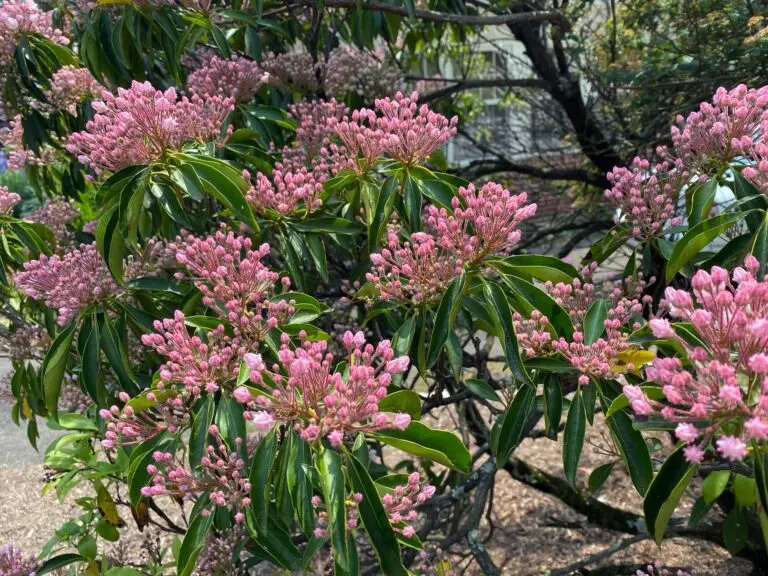
Mountain laurel...or azalea?
What’s the difference between mountain laurels, azaleas, and rhododendrons?
All three of these shrubs get confused for good reason—they have many similarities. All three are flowering shrubs with native options for North American gardens.
To learn more about their differences, visit our article aptly titled Azaleas vs. Mountain Laurels vs. Rhododendrons—What’s the Difference?
Mountain laurels are deer-proof
Deer do NOT eat mountain laurels. If you’re worried about deer nibbling your garden, planting mountain laurel is a good native gardening choice.
Where can I find native mountain laurels for my garden?
Sadly, showing up to a big-box store or even a local nursery might not turn up a native mountain laurel. But finding natives is easy—if you know where to look!
Here are four tried-and-true sources for finding native mountain laurels:
Where can I find seeds and plants?
Finding native plants can be challenging (we partly blame Marie Antoinette.) To make it easier, we’ve assembled four sourcing ideas.
300+ native nurseries make finding one a breeze
Explore 100+ native-friendly eCommerce sites
Every state and province has a native plant society; find yours
Online Communities
Local Facebook groups are a great plant source
What pairs well with native mountain laurel?
Mountain laurels are part of the Ericacea or Heath plant family, a group of around 4,000 species known for their love of acidic soil and wet areas. (Blueberries are also in this family.) Pair mountain laurels with other plants that thrive in these conditions, like native azaleas, blueberries, native rhododendrons, and winterberries. Here are some stellar combinations for your garden.

Pairs well with
To sum it up: mountain laurels are a stellar evergreen shrubs that look great planted in highly visible areas: front gardens, backyard edges, and property lines. Their dark green, glossy leaves look beautiful year-round. In the spring, they cover themselves in constellations of flowers. They are happy in a wide variety of light (shade, part shade, some sun). Plant a few and enjoy them for decades to come. Looking to meet other native shrubs? Visit our Beginner’s Guide to Native Azaleas or our Beginner’s Guide to Native Dogwoods. Happy planting!
Sources
- Harris, Marjorie. Botanica North America: The Illustrated Guide to Our Native Plants, Their Botany, History, and the Way They Have Shaped Our World. (2003), 175-176.
- Lorimer, Uli. The Northeast Native Plant Primer. (2022), 94.
- Brooklyn Botanic Garden, Mountain Laurel.
- USDA Plant Profile, Kalmia latifolia.
- Missouri Botanical Garden, Kalmia latifolia.
What if your feed was actually good for your mental health?
Give your algorithm a breath of fresh air and follow us.
